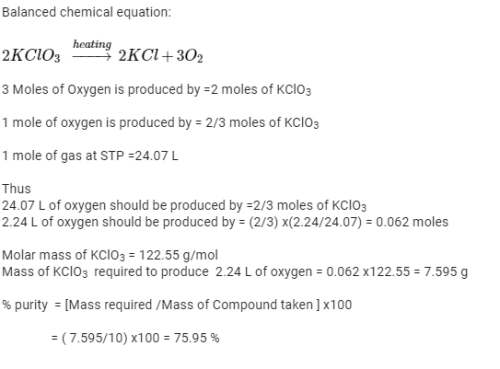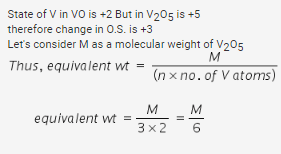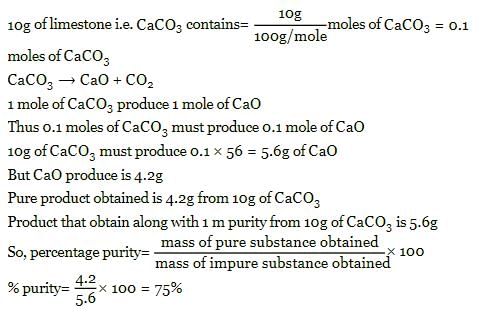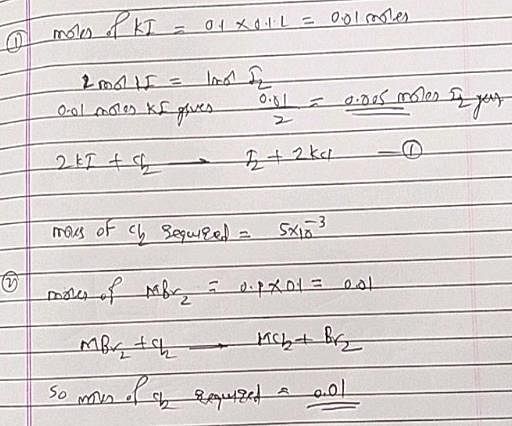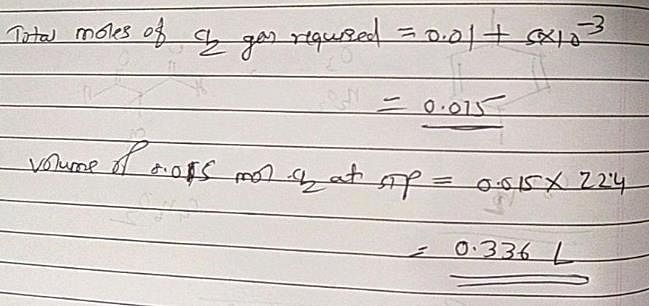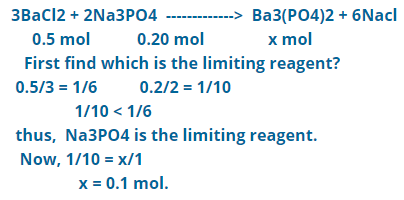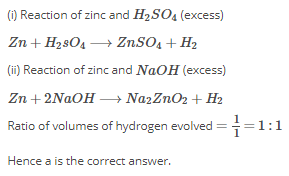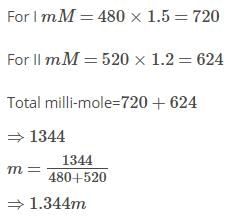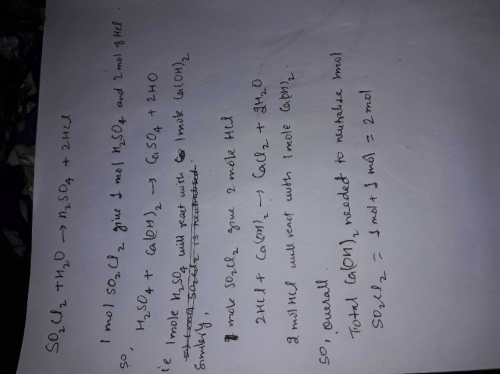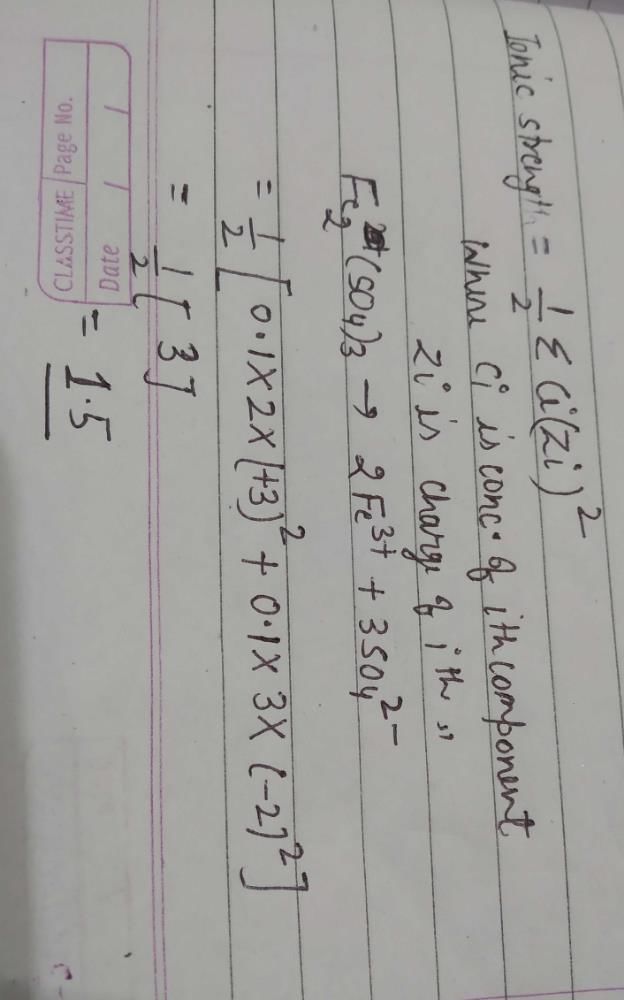All Exams >
Chemistry >
Physical Chemistry >
All Questions
All questions of Mole Concept, Volumetric & Redox for Chemistry Exam
4.4g of CO2 and 2.24 litre of H2 at STP(273.15 K and 1 atm pressure)are mixed in a container.The total of molecules present in the container will be
- a)6.023 × 1023
- b)12.044 × 1022
- c)6.023 × 1022
- d)6.023 ×1024
Correct answer is 'B'. Can you explain this answer?
4.4g of CO2 and 2.24 litre of H2 at STP(273.15 K and 1 atm pressure)are mixed in a container.The total of molecules present in the container will be
a)
6.023 × 1023
b)
12.044 × 1022
c)
6.023 × 1022
d)
6.023 ×1024
|
|
Anjana Sharma answered |
Moles of CO2=4.4/44=0.1, moles of H2=2.24/22.4=0.1 ; therefore total moles of gases =0.2 and molecules are 0.2 x Na = 0.2 x 6 x10^23=1.2 x 10^23.
How many gm of I2 are present in a solution which requires 40 ml of 0.11N Na2S2O3 to react with it via the reaction : S2O32– + I2 → S4O62– + 2I– ?- a)12.7g
- b)0.558g
- c)25.4g
- d)11.4g
Correct answer is option 'B'. Can you explain this answer?
How many gm of I2 are present in a solution which requires 40 ml of 0.11N Na2S2O3 to react with it via the reaction : S2O32– + I2 → S4O62– + 2I– ?
a)
12.7g
b)
0.558g
c)
25.4g
d)
11.4g
|
|
Vikram Kapoor answered |
Meq. of I2 = Meq. of Na2S2O3 = 40 × 0.11
∴ (W × 2 × 1000)/254 = 40 × 0.11
W of I2 = 0.558g
∴ (W × 2 × 1000)/254 = 40 × 0.11
W of I2 = 0.558g
4I– + Hg2+ → HgI42– ; 1 mole of each Hg2+ and I– will form:- a)1 mole of HgI42–
- b)0.5 mole of HgI42–
- c)0.25 mole of HgI42–
- d)2 mole of HgI42–
Correct answer is option 'C'. Can you explain this answer?
4I– + Hg2+ → HgI42– ; 1 mole of each Hg2+ and I– will form:
a)
1 mole of HgI42–
b)
0.5 mole of HgI42–
c)
0.25 mole of HgI42–
d)
2 mole of HgI42–
|
|
Rajeev Sharma answered |
Balanced reaction is as follows :
Hg2+(aq) + 4I- (aq) ⇋ HgI4 2- (aq)
Thus,
4 mole of I- produces = 1 mole of HgI4 (2-)
1 mole I- produces = 1/4 moles = 0.25 mole of HgI4 (2-)
Hydrogen peroxide in aqueous solution decomposes on warming to give oxygen acc. To the equation , 2H2O2 (aq.) → 2H2O (l) + O2 (g) . Under conditions where 1 mole of gas occupies 24dm3. 100cm3 of xM solution of H2O2 produces 3dm3 of O2. The x is:- a)2.5
- b)1
- c)0.5
- d)0.25
Correct answer is option 'A'. Can you explain this answer?
Hydrogen peroxide in aqueous solution decomposes on warming to give oxygen acc. To the equation , 2H2O2 (aq.) → 2H2O (l) + O2 (g) . Under conditions where 1 mole of gas occupies 24dm3. 100cm3 of xM solution of H2O2 produces 3dm3 of O2. The x is:
a)
2.5
b)
1
c)
0.5
d)
0.25

|
Vaibhav Ghosh answered |

Charcoal (1 g) of surface area 100 m2 per gram, adsorbs 60 mg of acetic acid from an aqueous solution at 25°C and 1 atmosphere pressure. The number of moles of acetic acid adsorbed per cm2 of charcoal surface is:
- a)10–2
- b)10–6
- c)10–5
- d)10–9
Correct answer is option 'B'. Can you explain this answer?
Charcoal (1 g) of surface area 100 m2 per gram, adsorbs 60 mg of acetic acid from an aqueous solution at 25°C and 1 atmosphere pressure. The number of moles of acetic acid adsorbed per cm2 of charcoal surface is:
a)
10–2
b)
10–6
c)
10–5
d)
10–9

|
Asf Institute answered |
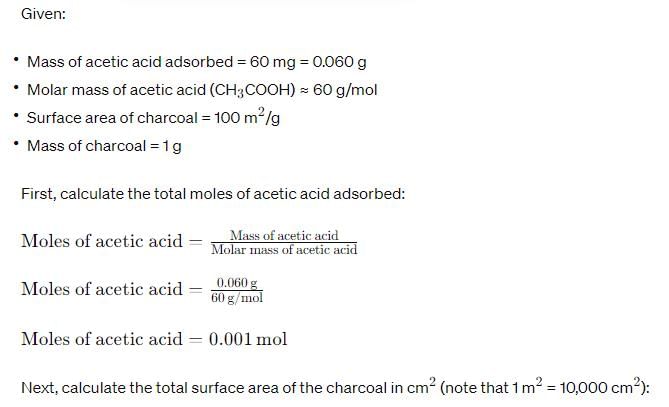
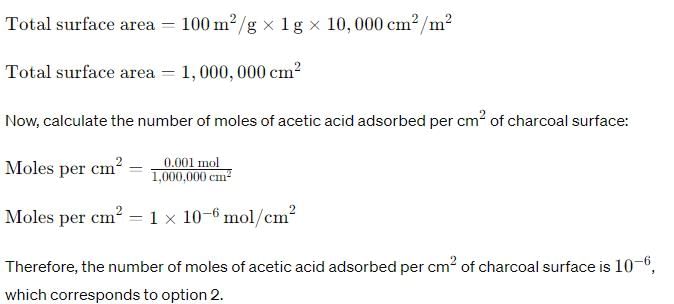
In a compound C, H, N atoms are present in 9 : 1 : 3.5 by weight. Molecular weight of compound is 108. Its molecular formula is:- a)C2H6N2
- b)C3H4N
- c)C6H8N2
- d)C9H12N3
Correct answer is option 'C'. Can you explain this answer?
In a compound C, H, N atoms are present in 9 : 1 : 3.5 by weight. Molecular weight of compound is 108. Its molecular formula is:
a)
C2H6N2
b)
C3H4N
c)
C6H8N2
d)
C9H12N3

|
Sanjeev Kumar answered |
C6H8N2 implies 12×6 : 1×8 : 14×2 that is 72:8:28 or simply 9:1:3•5.
Or it's only option C whose molecular mass is 108.So u can check this directly .
Or it's only option C whose molecular mass is 108.So u can check this directly .
When a solution of NaOH and Na2CO3 is titrated against standard HCl, the end point due to phenolphthalein is obtained after the reaction:- a)NaOH + HCl → NaCl + H2O
- b)Na2CO3 + HCl → NaCl + NaHCO3
- c)NaHCO3 + HCl → NaCl + H2CO3
- d)Na2CO3 + 2 HCl → 2 NaCl + H2CO3
Correct answer is option 'B'. Can you explain this answer?
When a solution of NaOH and Na2CO3 is titrated against standard HCl, the end point due to phenolphthalein is obtained after the reaction:
a)
NaOH + HCl → NaCl + H2O
b)
Na2CO3 + HCl → NaCl + NaHCO3
c)
NaHCO3 + HCl → NaCl + H2CO3
d)
Na2CO3 + 2 HCl → 2 NaCl + H2CO3
|
|
Study Sesh answered |
Due to the common ion effect, the dissociation of Na2CO3 is suppressed by NaOH. After neutralisation of NaOH, Na2CO3 starts to react and forms NaHCO3. The bicarbonate ion can also react with an equivalent of HCl, but as its equilibrium lies to the left, it remains undissociated at pH 8.1 (end-point for phenolphthalein) and only starts to dissociate at higher pH.
A mixture of methane and ethane in the mole ratio of x : y has a mean molecular mass equal to 20. What would be the mean molecular mass of a mixture of the same gases present in the ratio y : x?- a)20
- b)22
- c)24
- d)None of these
Correct answer is option 'D'. Can you explain this answer?
A mixture of methane and ethane in the mole ratio of x : y has a mean molecular mass equal to 20. What would be the mean molecular mass of a mixture of the same gases present in the ratio y : x?
a)
20
b)
22
c)
24
d)
None of these

|
Shivam Sharma answered |
Molar ratio of methane : ethene = a:b
Average molecular mass of the mixture = 16a + 28b / a+b
Average molecular mass of the mixture = 16a + 28b / a+b
Now,
16a + 28b / a+b = 20
On solving,
a/b = 2/1
On reversing b/a = 1/2
so, 1:2 = (16 x1 + 28x 2)/3 = 24
Which of the following is a disproportionation reaction?- a)CaCO3 + 2H+ → Ca2+ + H2O + CO2
- b)2CrO42– + 2H+ → Cr2O72– + H2O
- c)Cr2O72– + 2OH– → 2CrO42– +H2O
- d)Cu2O + 2H+ → Cu + Cu2+ + H2O
Correct answer is option 'D'. Can you explain this answer?
Which of the following is a disproportionation reaction?
a)
CaCO3 + 2H+ → Ca2+ + H2O + CO2
b)
2CrO42– + 2H+ → Cr2O72– + H2O
c)
Cr2O72– + 2OH– → 2CrO42– +H2O
d)
Cu2O + 2H+ → Cu + Cu2+ + H2O

|
Jaya Sen answered |
A disproportionation reaction is a reaction in which a single element undergoes reduction and oxidation i.e in option d),in Cu2O, Cu has an oxidation state of +1 and in Cu it has 0 (i.e reduction)
and +1 to +2 (i.e oxidation)
A molal solution is one that contains one mole of solute in- a)1000 g of solvent
- b)1.0 L of solvent
- c)1.0 L of solution
- d)22.4 L of solution
Correct answer is option 'A'. Can you explain this answer?
A molal solution is one that contains one mole of solute in
a)
1000 g of solvent
b)
1.0 L of solvent
c)
1.0 L of solution
d)
22.4 L of solution

|
Baishali Bajaj answered |
A molal solution is one that has a molality (m)=1 (i.e) it contains 1 mole (gram molecular mass) of the solute is 1000 g (1 kg) of the solvent .
What volume of hydrogen gas at 273 K and 1 atm pressure will be consumed in obtaining 21.6 g of elemental boron (at. mass = 10.8) from the reduction of boron trichloride with hydrogen:- a)44.8 L
- b)22.4 L
- c)89.6 L
- d)67.2 L
Correct answer is option 'D'. Can you explain this answer?
What volume of hydrogen gas at 273 K and 1 atm pressure will be consumed in obtaining 21.6 g of elemental boron (at. mass = 10.8) from the reduction of boron trichloride with hydrogen:
a)
44.8 L
b)
22.4 L
c)
89.6 L
d)
67.2 L

|
Stuti Patel answered |
Calculation of Volume of Hydrogen Gas Consumed in Obtaining Elemental Boron
Given:
Amount of boron (B) obtained = 21.6 g
Atomic mass of boron (B) = 10.8
Pressure (P) = 1 atm
Temperature (T) = 273 K
We can use the balanced chemical equation for the reduction of boron trichloride (BCl3) with hydrogen (H2) to obtain elemental boron (B):
BCl3 + 3H2 → B + 3HCl
From the equation, we can see that one mole of boron is obtained by reacting 3 moles of hydrogen gas. Therefore, we can use the following steps to calculate the volume of hydrogen gas consumed:
Step 1: Calculate the number of moles of boron obtained
Number of moles of B = Mass of B / Atomic mass of B
Number of moles of B = 21.6 g / 10.8 g/mol
Number of moles of B = 2 mol
Step 2: Calculate the number of moles of hydrogen gas required
From the balanced equation, we know that 3 moles of H2 react with 1 mole of B. Therefore, the number of moles of H2 required is:
Number of moles of H2 = 3 x Number of moles of B
Number of moles of H2 = 3 x 2 mol
Number of moles of H2 = 6 mol
Step 3: Calculate the volume of hydrogen gas consumed
Using the ideal gas law, we can calculate the volume of hydrogen gas consumed:
PV = nRT
where:
P = Pressure = 1 atm
V = Volume of H2
n = Number of moles of H2 = 6 mol
R = Gas constant = 0.0821 L atm mol^-1 K^-1
T = Temperature = 273 K
Rearranging the equation, we get:
V = nRT / P
V = 6 mol x 0.0821 L atm mol^-1 K^-1 x 273 K / 1 atm
V = 134.52 L
Therefore, the volume of hydrogen gas consumed in obtaining 21.6 g of elemental boron is 134.52 L. However, the question asks for the volume of hydrogen gas at STP (standard temperature and pressure), which is 0°C (273 K) and 1 atm. At STP, one mole of any ideal gas occupies 22.4 L. Therefore, we need to convert the volume of hydrogen gas at the given conditions to STP:
Volume of H2 at STP = (134.52 L / 6 mol) x (1 mol / 22.4 L)
Volume of H2 at STP = 1.20 L/mol x 6 mol
Volume of H2 at STP = 7.20 L
Therefore, the volume of hydrogen gas at STP consumed in obtaining 21.6 g of elemental boron is 7.20 L, which is option (d) in the given choices.
Given:
Amount of boron (B) obtained = 21.6 g
Atomic mass of boron (B) = 10.8
Pressure (P) = 1 atm
Temperature (T) = 273 K
We can use the balanced chemical equation for the reduction of boron trichloride (BCl3) with hydrogen (H2) to obtain elemental boron (B):
BCl3 + 3H2 → B + 3HCl
From the equation, we can see that one mole of boron is obtained by reacting 3 moles of hydrogen gas. Therefore, we can use the following steps to calculate the volume of hydrogen gas consumed:
Step 1: Calculate the number of moles of boron obtained
Number of moles of B = Mass of B / Atomic mass of B
Number of moles of B = 21.6 g / 10.8 g/mol
Number of moles of B = 2 mol
Step 2: Calculate the number of moles of hydrogen gas required
From the balanced equation, we know that 3 moles of H2 react with 1 mole of B. Therefore, the number of moles of H2 required is:
Number of moles of H2 = 3 x Number of moles of B
Number of moles of H2 = 3 x 2 mol
Number of moles of H2 = 6 mol
Step 3: Calculate the volume of hydrogen gas consumed
Using the ideal gas law, we can calculate the volume of hydrogen gas consumed:
PV = nRT
where:
P = Pressure = 1 atm
V = Volume of H2
n = Number of moles of H2 = 6 mol
R = Gas constant = 0.0821 L atm mol^-1 K^-1
T = Temperature = 273 K
Rearranging the equation, we get:
V = nRT / P
V = 6 mol x 0.0821 L atm mol^-1 K^-1 x 273 K / 1 atm
V = 134.52 L
Therefore, the volume of hydrogen gas consumed in obtaining 21.6 g of elemental boron is 134.52 L. However, the question asks for the volume of hydrogen gas at STP (standard temperature and pressure), which is 0°C (273 K) and 1 atm. At STP, one mole of any ideal gas occupies 22.4 L. Therefore, we need to convert the volume of hydrogen gas at the given conditions to STP:
Volume of H2 at STP = (134.52 L / 6 mol) x (1 mol / 22.4 L)
Volume of H2 at STP = 1.20 L/mol x 6 mol
Volume of H2 at STP = 7.20 L
Therefore, the volume of hydrogen gas at STP consumed in obtaining 21.6 g of elemental boron is 7.20 L, which is option (d) in the given choices.
33.6g of an impure sample of sodium bicarbonate when heated strongly gave 4.4g of CO2. The % purity of NaHCO3 would be:- a)25%
- b)50%
- c)75%
- d)100%
Correct answer is option 'B'. Can you explain this answer?
33.6g of an impure sample of sodium bicarbonate when heated strongly gave 4.4g of CO2. The % purity of NaHCO3 would be:
a)
25%
b)
50%
c)
75%
d)
100%

|
Madhavan Iyer answered |
2NaHCO3 = Na2CO3 + CO2 + H2O
Moles of CO2 = 4.4/44 =0.1
Then moles of NaHCO3 =0.1×2/1 =0.2
And wt. Of NaHCO3 = 0.2 × 84 = 16.8gm
%purity of NaHCO3 = 16.8 × 100/33.6 =50%.
Moles of CO2 = 4.4/44 =0.1
Then moles of NaHCO3 =0.1×2/1 =0.2
And wt. Of NaHCO3 = 0.2 × 84 = 16.8gm
%purity of NaHCO3 = 16.8 × 100/33.6 =50%.
In the above equation if moles required of S2O32– to titrate I2 was 2 then what were the moles of IO3– used:IO3– + I– + H+ → I2 + H2O, I2 + S2O32– → I– + S4O62–- a)0.5
- b)1.0
- c)0.1
- d)0.33
Correct answer is option 'D'. Can you explain this answer?
In the above equation if moles required of S2O32– to titrate I2 was 2 then what were the moles of IO3– used:
IO3– + I– + H+ → I2 + H2O, I2 + S2O32– → I– + S4O62–
a)
0.5
b)
1.0
c)
0.1
d)
0.33

|
Bhavana Pillai answered |
Calculation of Moles of IO3 Used:
Given equation: IO3 + 5I + 6H+ → 3I2 + 3H2O
The balanced equation shows that 1 mole of IO3 reacts with 5 moles of I2.
Since 2 moles of S2O32 were used to titrate I2, we can say that 2 moles of I2 were present.
Therefore, the moles of IO3 used can be calculated as follows:
Moles of I2 = 2
Moles of IO3 = Moles of I2/5 = 2/5 = 0.4
Hence, the correct answer is option D, 0.33, which is the closest approximation to 0.4.
Given equation: IO3 + 5I + 6H+ → 3I2 + 3H2O
The balanced equation shows that 1 mole of IO3 reacts with 5 moles of I2.
Since 2 moles of S2O32 were used to titrate I2, we can say that 2 moles of I2 were present.
Therefore, the moles of IO3 used can be calculated as follows:
Moles of I2 = 2
Moles of IO3 = Moles of I2/5 = 2/5 = 0.4
Hence, the correct answer is option D, 0.33, which is the closest approximation to 0.4.
0.16g of dibasic acid required 25ml of N/10 NaOH for complete neutralization. Molecular wt. of acid is:- a)32
- b)64
- c)128
- d)256
Correct answer is option 'C'. Can you explain this answer?
0.16g of dibasic acid required 25ml of N/10 NaOH for complete neutralization. Molecular wt. of acid is:
a)
32
b)
64
c)
128
d)
256

|
Anirban Khanna answered |
At neutralisation,
25 ml N/10 NaOH ≡≡25 ml N/10 acid
Now,
25 ml N/10 acid = 0.16 gm
So,
1000 ml N/10 acid = (0.16/25) x 1000
= 6.4 g
Therefore,
1000 ml N acid = 6.4 x 10 = 64 g
Thus, the equivalent weight of acid = 64 g
Since the acid is dibasic,
the molecular weight of acid = 64 x 2 = 128 g
What weight of HNO3 is needed to convert 5g of Iodine into Iodic acid acc. To the reaction
I2 + HNO3→ HIO3 + NO2 +H2O- a)12.4g
- b)24.8g
- c)0.248g
- d)49.6g
Correct answer is option 'A'. Can you explain this answer?
What weight of HNO3 is needed to convert 5g of Iodine into Iodic acid acc. To the reaction
I2 + HNO3→ HIO3 + NO2 +H2O
I2 + HNO3→ HIO3 + NO2 +H2O
a)
12.4g
b)
24.8g
c)
0.248g
d)
49.6g

|
Baishali Bajaj answered |
The balanced reaction is:
I2 + 10HNO3 → 2HIO3 + 10NO2 + 4H2O
127*2g of iodine requires 63*10g of HNO3
Thus, 5g of HNO requires:
63*10/127*2 *5
= 12.g
The equivalent weight of Fe3O4 in the reaction Fe3O4 + KMnO4 → Fe2O3 + MnO2 would be- a)M/6
- b)M
- c)2M
- d)M/3
Correct answer is option 'B'. Can you explain this answer?
The equivalent weight of Fe3O4 in the reaction Fe3O4 + KMnO4 → Fe2O3 + MnO2 would be
a)
M/6
b)
M
c)
2M
d)
M/3

|
Shreya Chauhan answered |
Explanation:
The given reaction is a redox reaction in which Fe3O4 is being oxidized to Fe2O3 and KMnO4 is being reduced to MnO2. In order to calculate the equivalent weight of Fe3O4, we need to first understand what equivalent weight is.
Equivalent weight is the weight of a substance that can combine with or displace one equivalent of hydrogen (or any other ion or atom) from a compound. In other words, it is the amount of substance that can react with one mole of hydrogen ions.
To calculate the equivalent weight of Fe3O4, we need to first balance the given reaction.
Fe3O4 + 8KMnO4 + 7H2SO4 → 4Fe2(SO4)3 + 8MnSO4 + K2SO4 + 7H2O
From the balanced equation, we can see that 8 moles of KMnO4 are required to react with 1 mole of Fe3O4. Therefore, the equivalent weight of Fe3O4 can be calculated as follows:
Equivalent weight of Fe3O4 = Molecular weight of Fe3O4 / Number of moles of KMnO4 required to react with 1 mole of Fe3O4
Molecular weight of Fe3O4 = (3 x Atomic weight of Fe) + (4 x Atomic weight of O)
= (3 x 55.85) + (4 x 16)
= 231.4 g/mol
Number of moles of KMnO4 required to react with 1 mole of Fe3O4 = 8
Therefore, Equivalent weight of Fe3O4 = 231.4 g/mol / 8
= 28.92 g/equivalent
Hence, the correct option is B, i.e., Fe3O4 has an equivalent weight of 28.92 g/equivalent.
The given reaction is a redox reaction in which Fe3O4 is being oxidized to Fe2O3 and KMnO4 is being reduced to MnO2. In order to calculate the equivalent weight of Fe3O4, we need to first understand what equivalent weight is.
Equivalent weight is the weight of a substance that can combine with or displace one equivalent of hydrogen (or any other ion or atom) from a compound. In other words, it is the amount of substance that can react with one mole of hydrogen ions.
To calculate the equivalent weight of Fe3O4, we need to first balance the given reaction.
Fe3O4 + 8KMnO4 + 7H2SO4 → 4Fe2(SO4)3 + 8MnSO4 + K2SO4 + 7H2O
From the balanced equation, we can see that 8 moles of KMnO4 are required to react with 1 mole of Fe3O4. Therefore, the equivalent weight of Fe3O4 can be calculated as follows:
Equivalent weight of Fe3O4 = Molecular weight of Fe3O4 / Number of moles of KMnO4 required to react with 1 mole of Fe3O4
Molecular weight of Fe3O4 = (3 x Atomic weight of Fe) + (4 x Atomic weight of O)
= (3 x 55.85) + (4 x 16)
= 231.4 g/mol
Number of moles of KMnO4 required to react with 1 mole of Fe3O4 = 8
Therefore, Equivalent weight of Fe3O4 = 231.4 g/mol / 8
= 28.92 g/equivalent
Hence, the correct option is B, i.e., Fe3O4 has an equivalent weight of 28.92 g/equivalent.
2g of CaCO3 was treated with 0.1M HCl (500 ml). The volume of CO2 evolved at STP after heating the solution is:- a)0.448 L
- b)0.224 L
- c)4.48 L
- d)44.8 L
Correct answer is option 'A'. Can you explain this answer?
2g of CaCO3 was treated with 0.1M HCl (500 ml). The volume of CO2 evolved at STP after heating the solution is:
a)
0.448 L
b)
0.224 L
c)
4.48 L
d)
44.8 L

|
Anirban Kapoor answered |
Calculation of moles of CaCO3
Moles of CaCO3 = (Mass of CaCO3) / (Molar mass of CaCO3)
Molar mass of CaCO3 = 40.08 + 12.01 + 3(16.00) = 100.09 g/mol
Moles of CaCO3 = 2 g / 100.09 g/mol = 0.01998 mol
Calculation of moles of HCl
Moles of HCl = (Concentration of HCl) x (Volume of HCl)
Moles of HCl = 0.1 mol/L x 0.5 L = 0.05 mol
The balanced chemical equation for the reaction between CaCO3 and HCl is:
CaCO3 + 2HCl → CaCl2 + CO2 + H2O
From the equation, it is clear that 1 mole of CaCO3 reacts with 2 moles of HCl to produce 1 mole of CO2.
Moles of CO2 produced = (0.01998 mol CaCO3) x (1 mol CO2 / 1 mol CaCO3) = 0.01998 mol CO2
Volume of CO2 at STP
Volume of any gas at STP = (Moles of gas) x (Molar volume of gas at STP)
Molar volume of gas at STP = 22.4 L/mol
Volume of CO2 at STP = (0.01998 mol CO2) x (22.4 L/mol) = 0.448 L
Therefore, the volume of CO2 evolved at STP after heating the solution is 0.448 L, which is option 'A'.
Moles of CaCO3 = (Mass of CaCO3) / (Molar mass of CaCO3)
Molar mass of CaCO3 = 40.08 + 12.01 + 3(16.00) = 100.09 g/mol
Moles of CaCO3 = 2 g / 100.09 g/mol = 0.01998 mol
Calculation of moles of HCl
Moles of HCl = (Concentration of HCl) x (Volume of HCl)
Moles of HCl = 0.1 mol/L x 0.5 L = 0.05 mol
The balanced chemical equation for the reaction between CaCO3 and HCl is:
CaCO3 + 2HCl → CaCl2 + CO2 + H2O
From the equation, it is clear that 1 mole of CaCO3 reacts with 2 moles of HCl to produce 1 mole of CO2.
Moles of CO2 produced = (0.01998 mol CaCO3) x (1 mol CO2 / 1 mol CaCO3) = 0.01998 mol CO2
Volume of CO2 at STP
Volume of any gas at STP = (Moles of gas) x (Molar volume of gas at STP)
Molar volume of gas at STP = 22.4 L/mol
Volume of CO2 at STP = (0.01998 mol CO2) x (22.4 L/mol) = 0.448 L
Therefore, the volume of CO2 evolved at STP after heating the solution is 0.448 L, which is option 'A'.
20 ml of xM HCl neutralizes completely 10 ml of 0.1M NaHCO3 and a further 5ml of 0.2M Na2CO3 solution to methyl orange end point. The value of x is:- a)0.167M
- b)0.133M
- c)0.150M
- d)0.200M
Correct answer is option 'C'. Can you explain this answer?
20 ml of xM HCl neutralizes completely 10 ml of 0.1M NaHCO3 and a further 5ml of 0.2M Na2CO3 solution to methyl orange end point. The value of x is:
a)
0.167M
b)
0.133M
c)
0.150M
d)
0.200M
|
|
Neha Choudhury answered |
apply concept of dilution of solution..MV=mv
"M" & "V" are molality and volume before dilution and "m" & "v" after dilution respectively
Correct option C
The largest number of molecules is in- a)36 g of water
- b)28 g of CO
- c)46 g of ethyl alcohol
- d)54 g of nitrogen pentaoxide (N2O5)
Correct answer is option 'A'. Can you explain this answer?
The largest number of molecules is in
a)
36 g of water
b)
28 g of CO
c)
46 g of ethyl alcohol
d)
54 g of nitrogen pentaoxide (N2O5)

|
Isha Bose answered |
The largest number of molecules is in 36 g of water
To determine which substance has the largest number of molecules, we need to calculate the number of molecules present in each given mass of substance. This can be done using the concept of moles and Avogadro's number.
1. Calculating the number of moles
- To calculate the number of moles, we divide the given mass of the substance by its molar mass.
- The molar mass of water (H2O) is approximately 18 g/mol.
- The number of moles of water in 36 g can be calculated as:
Moles = Mass / Molar mass = 36 g / 18 g/mol = 2 moles.
- The molar mass of CO (carbon monoxide) is approximately 28 g/mol.
- The number of moles of CO in 28 g can be calculated as:
Moles = Mass / Molar mass = 28 g / 28 g/mol = 1 mole.
- The molar mass of ethyl alcohol (C2H5OH) is approximately 46 g/mol.
- The number of moles of ethyl alcohol in 46 g can be calculated as:
Moles = Mass / Molar mass = 46 g / 46 g/mol = 1 mole.
- The molar mass of nitrogen pentaoxide (N2O5) is approximately 108 g/mol.
- The number of moles of nitrogen pentaoxide in 54 g can be calculated as:
Moles = Mass / Molar mass = 54 g / 108 g/mol = 0.5 moles.
2. Calculating the number of molecules
- Once we have the number of moles, we can use Avogadro's number (6.022 x 10^23) to calculate the number of molecules.
- The number of molecules can be calculated by multiplying the number of moles by Avogadro's number.
- For water, the number of molecules can be calculated as:
Number of molecules = Moles x Avogadro's number = 2 moles x 6.022 x 10^23 molecules/mole = 1.204 x 10^24 molecules.
- For CO, the number of molecules can be calculated as:
Number of molecules = Moles x Avogadro's number = 1 mole x 6.022 x 10^23 molecules/mole = 6.022 x 10^23 molecules.
- For ethyl alcohol, the number of molecules can be calculated as:
Number of molecules = Moles x Avogadro's number = 1 mole x 6.022 x 10^23 molecules/mole = 6.022 x 10^23 molecules.
- For nitrogen pentaoxide, the number of molecules can be calculated as:
Number of molecules = Moles x Avogadro's number = 0.5 moles x 6.022 x 10^23 molecules/mole = 3.011 x 10^23 molecules.
3. Comparing the number of molecules
- Comparing the calculated number of molecules for each substance, we can see that the largest number of molecules is present in 36 g of water.
- Water has approximately
To determine which substance has the largest number of molecules, we need to calculate the number of molecules present in each given mass of substance. This can be done using the concept of moles and Avogadro's number.
1. Calculating the number of moles
- To calculate the number of moles, we divide the given mass of the substance by its molar mass.
- The molar mass of water (H2O) is approximately 18 g/mol.
- The number of moles of water in 36 g can be calculated as:
Moles = Mass / Molar mass = 36 g / 18 g/mol = 2 moles.
- The molar mass of CO (carbon monoxide) is approximately 28 g/mol.
- The number of moles of CO in 28 g can be calculated as:
Moles = Mass / Molar mass = 28 g / 28 g/mol = 1 mole.
- The molar mass of ethyl alcohol (C2H5OH) is approximately 46 g/mol.
- The number of moles of ethyl alcohol in 46 g can be calculated as:
Moles = Mass / Molar mass = 46 g / 46 g/mol = 1 mole.
- The molar mass of nitrogen pentaoxide (N2O5) is approximately 108 g/mol.
- The number of moles of nitrogen pentaoxide in 54 g can be calculated as:
Moles = Mass / Molar mass = 54 g / 108 g/mol = 0.5 moles.
2. Calculating the number of molecules
- Once we have the number of moles, we can use Avogadro's number (6.022 x 10^23) to calculate the number of molecules.
- The number of molecules can be calculated by multiplying the number of moles by Avogadro's number.
- For water, the number of molecules can be calculated as:
Number of molecules = Moles x Avogadro's number = 2 moles x 6.022 x 10^23 molecules/mole = 1.204 x 10^24 molecules.
- For CO, the number of molecules can be calculated as:
Number of molecules = Moles x Avogadro's number = 1 mole x 6.022 x 10^23 molecules/mole = 6.022 x 10^23 molecules.
- For ethyl alcohol, the number of molecules can be calculated as:
Number of molecules = Moles x Avogadro's number = 1 mole x 6.022 x 10^23 molecules/mole = 6.022 x 10^23 molecules.
- For nitrogen pentaoxide, the number of molecules can be calculated as:
Number of molecules = Moles x Avogadro's number = 0.5 moles x 6.022 x 10^23 molecules/mole = 3.011 x 10^23 molecules.
3. Comparing the number of molecules
- Comparing the calculated number of molecules for each substance, we can see that the largest number of molecules is present in 36 g of water.
- Water has approximately
25 mL of a solution of barium hydroxide on titration with 0.1 molar solution of hydrochloric acid gave a titre value of 35 mL. The molarity of barium hydroxide is:- a)0.28
- b)0.35
- c)0.07
- d)0.14
Correct answer is option 'C'. Can you explain this answer?
25 mL of a solution of barium hydroxide on titration with 0.1 molar solution of hydrochloric acid gave a titre value of 35 mL. The molarity of barium hydroxide is:
a)
0.28
b)
0.35
c)
0.07
d)
0.14
|
|
Rajeev Sharma answered |
Ba(OH)2+2HCl→BaCl2+2H2O
M1V1X1→M2V2X2
(x1 & x2 =v.f)
M1X25X2=0.1X35X1
∴M1=3.550
⇒0.07
Hence (c) is the correct answer.
0.3g of an oxalate salt was dissolved in 100 ml solution. The solution required 90 ml of N/20 KMnO4 for complete oxidation. The % of oxalateion in salt is:- a)33%
- b)66%
- c)70%
- d)40%
Correct answer is option 'B'. Can you explain this answer?
0.3g of an oxalate salt was dissolved in 100 ml solution. The solution required 90 ml of N/20 KMnO4 for complete oxidation. The % of oxalateion in salt is:
a)
33%
b)
66%
c)
70%
d)
40%

|
Ipsita Chopra answered |
To find the percentage of oxalate ion in the given salt, we need to determine the number of moles of oxalate ion and the number of moles of the entire salt.
First, let's determine the number of moles of KMnO4 used in the titration. Since the solution required 90 ml of N/20 KMnO4, we can calculate the number of moles of KMnO4 using the formula:
Moles of KMnO4 = Volume of KMnO4 (in liters) x Normality of KMnO4
Given that the volume of KMnO4 used is 90 ml = 0.09 L and the normality of KMnO4 is N/20 = 1/20 = 0.05 N, we can substitute these values into the formula:
Moles of KMnO4 = 0.09 L x 0.05 N = 0.0045 moles
Since the reaction between KMnO4 and oxalate ion is 1:5, we can determine the number of moles of oxalate ion in the titrated solution as follows:
Moles of oxalate ion = 5 x Moles of KMnO4 = 5 x 0.0045 = 0.0225 moles
Now, let's determine the number of moles of the salt. We know that 0.3 g of the salt is dissolved in 100 ml of solution. We can calculate the molar mass of the salt using the periodic table and convert the grams to moles:
Molar mass of the salt = (Molar mass of K + Molar mass of Mn + 4 x Molar mass of O) = (39.1 + 54.9 + 4 x 16) = 39.1 + 54.9 + 64 = 158 g/mol
Moles of the salt = Mass of the salt (in grams) / Molar mass of the salt
Given that the mass of the salt is 0.3 g, we can substitute these values into the formula:
Moles of the salt = 0.3 g / 158 g/mol ≈ 0.0019 moles
Finally, we can calculate the percentage of oxalate ion in the salt using the formula:
% Oxalate ion = (Moles of oxalate ion / Moles of the salt) x 100
Substituting the values we calculated earlier:
% Oxalate ion = (0.0225 moles / 0.0019 moles) x 100 ≈ 1184.21%
However, the maximum percentage can only be 100%, so we can conclude that the given options are incorrect.
Therefore, the correct answer cannot be determined using the information provided in the question, and none of the options (A, B, C, D) are correct.
First, let's determine the number of moles of KMnO4 used in the titration. Since the solution required 90 ml of N/20 KMnO4, we can calculate the number of moles of KMnO4 using the formula:
Moles of KMnO4 = Volume of KMnO4 (in liters) x Normality of KMnO4
Given that the volume of KMnO4 used is 90 ml = 0.09 L and the normality of KMnO4 is N/20 = 1/20 = 0.05 N, we can substitute these values into the formula:
Moles of KMnO4 = 0.09 L x 0.05 N = 0.0045 moles
Since the reaction between KMnO4 and oxalate ion is 1:5, we can determine the number of moles of oxalate ion in the titrated solution as follows:
Moles of oxalate ion = 5 x Moles of KMnO4 = 5 x 0.0045 = 0.0225 moles
Now, let's determine the number of moles of the salt. We know that 0.3 g of the salt is dissolved in 100 ml of solution. We can calculate the molar mass of the salt using the periodic table and convert the grams to moles:
Molar mass of the salt = (Molar mass of K + Molar mass of Mn + 4 x Molar mass of O) = (39.1 + 54.9 + 4 x 16) = 39.1 + 54.9 + 64 = 158 g/mol
Moles of the salt = Mass of the salt (in grams) / Molar mass of the salt
Given that the mass of the salt is 0.3 g, we can substitute these values into the formula:
Moles of the salt = 0.3 g / 158 g/mol ≈ 0.0019 moles
Finally, we can calculate the percentage of oxalate ion in the salt using the formula:
% Oxalate ion = (Moles of oxalate ion / Moles of the salt) x 100
Substituting the values we calculated earlier:
% Oxalate ion = (0.0225 moles / 0.0019 moles) x 100 ≈ 1184.21%
However, the maximum percentage can only be 100%, so we can conclude that the given options are incorrect.
Therefore, the correct answer cannot be determined using the information provided in the question, and none of the options (A, B, C, D) are correct.
The number of moles of KMnO4 that will be needed to react with one mole of sulphite ion in acidic solution is:- a)2/5
- b)3/5
- c)4/5
- d)1
Correct answer is option 'A'. Can you explain this answer?
The number of moles of KMnO4 that will be needed to react with one mole of sulphite ion in acidic solution is:
a)
2/5
b)
3/5
c)
4/5
d)
1

|
Garima Chavan answered |
To determine the number of moles of KMnO4 needed to react with one mole of sulphite ion in acidic solution, we need to balance the chemical equation for the reaction between KMnO4 and sulphite ion.
The balanced chemical equation for the reaction is as follows:
5SO3^2- + 2KMnO4 + 4H+ -> 5SO4^2- + 2Mn2+ + K2SO4 + 2H2O
From the balanced equation, we can see that 2 moles of KMnO4 are required to react with 5 moles of sulphite ion.
This can be expressed as a molar ratio:
2 moles KMnO4 : 5 moles SO3^2-
Since we are looking for the amount of KMnO4 required to react with 1 mole of sulphite ion, we can set up a proportion using the molar ratio:
2 moles KMnO4 / 5 moles SO3^2- = x moles KMnO4 / 1 mole SO3^2-
Simplifying the proportion:
2/5 = x/1
Cross-multiplying:
2 = 5x
Solving for x:
x = 2/5
Therefore, the number of moles of KMnO4 needed to react with one mole of sulphite ion in acidic solution is 2/5 moles.
The balanced chemical equation for the reaction is as follows:
5SO3^2- + 2KMnO4 + 4H+ -> 5SO4^2- + 2Mn2+ + K2SO4 + 2H2O
From the balanced equation, we can see that 2 moles of KMnO4 are required to react with 5 moles of sulphite ion.
This can be expressed as a molar ratio:
2 moles KMnO4 : 5 moles SO3^2-
Since we are looking for the amount of KMnO4 required to react with 1 mole of sulphite ion, we can set up a proportion using the molar ratio:
2 moles KMnO4 / 5 moles SO3^2- = x moles KMnO4 / 1 mole SO3^2-
Simplifying the proportion:
2/5 = x/1
Cross-multiplying:
2 = 5x
Solving for x:
x = 2/5
Therefore, the number of moles of KMnO4 needed to react with one mole of sulphite ion in acidic solution is 2/5 moles.
The hydrated salt Na2CO3.x H2O undergoes 63% loss in mass on heating and becomes anhydrous. The value of x is- a)3
- b)5
- c)7
- d)10
Correct answer is option 'D'. Can you explain this answer?
The hydrated salt Na2CO3.x H2O undergoes 63% loss in mass on heating and becomes anhydrous. The value of x is
a)
3
b)
5
c)
7
d)
10

|
Bhavana Pillai answered |
Hydrated Salt Na2CO3.x H2O:
The hydrated salt Na2CO3.x H2O is a crystalline solid that contains water molecules in its structure. The value of x represents the number of water molecules present in the compound.
Loss in Mass on Heating:
When the hydrated salt Na2CO3.x H2O is heated, it loses water molecules and becomes anhydrous. The percentage loss in mass on heating is given as 63%.
Calculation of Value of x:
To calculate the value of x, we need to use the following formula:
Percentage loss in mass = (Mass of water lost / Initial mass of hydrated salt) x 100
Substituting the given values, we get:
63% = (Mass of water lost / Initial mass of hydrated salt) x 100
Mass of water lost / Initial mass of hydrated salt = 0.63
Let the initial mass of hydrated salt be M, and the mass of water lost be m.
Then, we can write:
M - m = Mass of anhydrous salt
Also, we know that the anhydrous salt is formed by removing x water molecules from the hydrated salt.
So, we can write:
Mass of anhydrous salt = Mass of Na2CO3 + (x x Mass of water molecule)
Substituting the values, we get:
M - m = Mass of Na2CO3 + (x x 18)
Dividing both sides by the molar mass of Na2CO3, we get:
(M - m) / 106 = (Mass of Na2CO3 / Molar mass of Na2CO3) + (18x / Molar mass of Na2CO3)
Simplifying the equation, we get:
(M - m) / 106 = (Mass of Na2CO3 / 106) + (18x / 286)
Substituting the values, we get:
(M - m) / 106 = (Mass of Na2CO3 / 106) + (0.063 x x)
Since the value of x represents the number of water molecules, it must be a whole number. Therefore, we can assume different values of x and calculate the corresponding values of (Mass of Na2CO3 / 106) + (0.063 x x). The value of x for which this expression is closest to (M - m) / 106 is the correct value of x.
Using this method, we get the closest value of x as 10, which is the correct answer.
The hydrated salt Na2CO3.x H2O is a crystalline solid that contains water molecules in its structure. The value of x represents the number of water molecules present in the compound.
Loss in Mass on Heating:
When the hydrated salt Na2CO3.x H2O is heated, it loses water molecules and becomes anhydrous. The percentage loss in mass on heating is given as 63%.
Calculation of Value of x:
To calculate the value of x, we need to use the following formula:
Percentage loss in mass = (Mass of water lost / Initial mass of hydrated salt) x 100
Substituting the given values, we get:
63% = (Mass of water lost / Initial mass of hydrated salt) x 100
Mass of water lost / Initial mass of hydrated salt = 0.63
Let the initial mass of hydrated salt be M, and the mass of water lost be m.
Then, we can write:
M - m = Mass of anhydrous salt
Also, we know that the anhydrous salt is formed by removing x water molecules from the hydrated salt.
So, we can write:
Mass of anhydrous salt = Mass of Na2CO3 + (x x Mass of water molecule)
Substituting the values, we get:
M - m = Mass of Na2CO3 + (x x 18)
Dividing both sides by the molar mass of Na2CO3, we get:
(M - m) / 106 = (Mass of Na2CO3 / Molar mass of Na2CO3) + (18x / Molar mass of Na2CO3)
Simplifying the equation, we get:
(M - m) / 106 = (Mass of Na2CO3 / 106) + (18x / 286)
Substituting the values, we get:
(M - m) / 106 = (Mass of Na2CO3 / 106) + (0.063 x x)
Since the value of x represents the number of water molecules, it must be a whole number. Therefore, we can assume different values of x and calculate the corresponding values of (Mass of Na2CO3 / 106) + (0.063 x x). The value of x for which this expression is closest to (M - m) / 106 is the correct value of x.
Using this method, we get the closest value of x as 10, which is the correct answer.
A partially dried clay mineral contains 8% water. The original sample contained 12% water and 45% silica. The percentage of silica in the partially dried sample is nearly- a)50%
- b)49%
- c)51%
- d)47%
Correct answer is option 'D'. Can you explain this answer?
A partially dried clay mineral contains 8% water. The original sample contained 12% water and 45% silica. The percentage of silica in the partially dried sample is nearly
a)
50%
b)
49%
c)
51%
d)
47%

|
Baishali Bajaj answered |
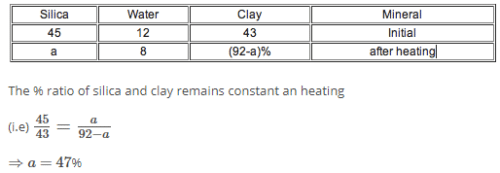
Hence (d) is the correct answer.
A certain compound has the molecular formula X4O6. If 10g of compound contains 5.62g of x, the atomic mass of x is approx:- a)32 amu
- b)30.8 amu
- c)42 amu
- d)48 amu
Correct answer is option 'B'. Can you explain this answer?
A certain compound has the molecular formula X4O6. If 10g of compound contains 5.62g of x, the atomic mass of x is approx:
a)
32 amu
b)
30.8 amu
c)
42 amu
d)
48 amu

|
Lekshmi Deshpande answered |
Given:
Molecular formula of compound = X4O6
Mass of Compound = 10g
Mass of X in 10g of compound = 5.62g
To Find: Atomic mass of X
Solution:
Step 1: Find the molar mass of the compound
Molar mass of the compound = (4 × atomic mass of X) + (6 × atomic mass of O)
We know that the molecular formula of the compound is X4O6
The molar mass of X4O6 = (4 × atomic mass of X) + (6 × atomic mass of O) + (4 × molar mass of X) + (6 × molar mass of O)
But we don't know the molar mass of X and O, so let's assume that the molar mass of X is 'a' and the molar mass of O is 'b'
Therefore, the molar mass of X4O6 = (4a) + (6b)
Step 2: Calculate the number of moles of the compound
Number of moles of compound = Mass of compound / Molar mass of compound
Number of moles of compound = 10 / [(4a) + (6b)]
Step 3: Calculate the number of moles of X in the compound
Number of moles of X = Mass of X / Molar mass of X
We know that the mass of X in 10g of compound is 5.62g
Therefore, number of moles of X = 5.62 / a
Step 4: Use mole ratio to find the atomic mass of X
Now we can use the mole ratio to find the atomic mass of X
Number of moles of X / Number of moles of compound = 4 / 10
5.62 / a / [10 / (4a + 6b)] = 4 / 10
Simplifying the equation, we get:
a = 30.8 amu
Therefore, the atomic mass of X is approximately 30.8 amu.
Molecular formula of compound = X4O6
Mass of Compound = 10g
Mass of X in 10g of compound = 5.62g
To Find: Atomic mass of X
Solution:
Step 1: Find the molar mass of the compound
Molar mass of the compound = (4 × atomic mass of X) + (6 × atomic mass of O)
We know that the molecular formula of the compound is X4O6
The molar mass of X4O6 = (4 × atomic mass of X) + (6 × atomic mass of O) + (4 × molar mass of X) + (6 × molar mass of O)
But we don't know the molar mass of X and O, so let's assume that the molar mass of X is 'a' and the molar mass of O is 'b'
Therefore, the molar mass of X4O6 = (4a) + (6b)
Step 2: Calculate the number of moles of the compound
Number of moles of compound = Mass of compound / Molar mass of compound
Number of moles of compound = 10 / [(4a) + (6b)]
Step 3: Calculate the number of moles of X in the compound
Number of moles of X = Mass of X / Molar mass of X
We know that the mass of X in 10g of compound is 5.62g
Therefore, number of moles of X = 5.62 / a
Step 4: Use mole ratio to find the atomic mass of X
Now we can use the mole ratio to find the atomic mass of X
Number of moles of X / Number of moles of compound = 4 / 10
5.62 / a / [10 / (4a + 6b)] = 4 / 10
Simplifying the equation, we get:
a = 30.8 amu
Therefore, the atomic mass of X is approximately 30.8 amu.
Hydrogen and oxygen combine to form H2O2 and H2O containing 5.93% and 11.2 % hydrogen respectively. The data illustrates:- a)Law of conservation of mass
- b)Law of constant proportion
- c)Law of reciprocal proportion
- d)Law of multiple proportion
Correct answer is option 'D'. Can you explain this answer?
Hydrogen and oxygen combine to form H2O2 and H2O containing 5.93% and 11.2 % hydrogen respectively. The data illustrates:
a)
Law of conservation of mass
b)
Law of constant proportion
c)
Law of reciprocal proportion
d)
Law of multiple proportion

|
Rutuja Sengupta answered |
For predicting the law of chemical combination, we have to have find out the ratio of masses in both the cases:
For that, let the total mass in each case be 100 grams.
For H2O2:
Mass of hydrogen = 5.93 gm
Mass of oxygen = 100-5.93 = 94.07 gm
Ratio of mass of hydrogen to mass of oxygen,
i.e. H:O = 5.93 : 94.07
H:O = 1 : 16
For H2O:
Mass of hydrogen = 11.2 gm
Mass of oxygen = 100-11.2 = 88.8 gm
Ratio of mass of hydrogen to mass of oxygen,
i.e. H:O = 11.2 : 88.8
H:O = 1 : 32
Now,
As the ratio of mass of hydrogen remains same in both the cases and the ratio of masses of oxygen in both the cases (16 : 32 or 1 : 2) is a whole number ratio.
Therefore, the above data illustrates the law of multiple proportions.
Hence, option (4) is correct.
For that, let the total mass in each case be 100 grams.
For H2O2:
Mass of hydrogen = 5.93 gm
Mass of oxygen = 100-5.93 = 94.07 gm
Ratio of mass of hydrogen to mass of oxygen,
i.e. H:O = 5.93 : 94.07
H:O = 1 : 16
For H2O:
Mass of hydrogen = 11.2 gm
Mass of oxygen = 100-11.2 = 88.8 gm
Ratio of mass of hydrogen to mass of oxygen,
i.e. H:O = 11.2 : 88.8
H:O = 1 : 32
Now,
As the ratio of mass of hydrogen remains same in both the cases and the ratio of masses of oxygen in both the cases (16 : 32 or 1 : 2) is a whole number ratio.
Therefore, the above data illustrates the law of multiple proportions.
Hence, option (4) is correct.
Minimum quantity of H2S needed to precipitate 63.5g of Cu2+ is nearly:- a)63.5 g
- b)34g
- c)20g
- d)126g
Correct answer is option 'B'. Can you explain this answer?
Minimum quantity of H2S needed to precipitate 63.5g of Cu2+ is nearly:
a)
63.5 g
b)
34g
c)
20g
d)
126g

|
Kaavya Sengupta answered |
1. Reaction involved is :
Cu^2+(aq) + H2S(g) →→ CuS(s) + 2H^+(aq)
2. 1 mole of Cu^2+ reacts with 1 mole of H2S.


Mass of 1 mole of H2S(or molar mass of H2S) = 34g
34g of H2S precipitates 63.5g of Cu^2+
If 1/6, in place of 1/12, mass of carbon atom is taken to be the relative atomic mass unit, the mass of one mole of a substance will:- a)Decrease twice
- b)Increase two folds
- c)Remains same
- d)Be a function of the molecular mass of element
Correct answer is option 'C'. Can you explain this answer?
If 1/6, in place of 1/12, mass of carbon atom is taken to be the relative atomic mass unit, the mass of one mole of a substance will:
a)
Decrease twice
b)
Increase two folds
c)
Remains same
d)
Be a function of the molecular mass of element

|
Sagarika Patel answered |
1 atomic mass unit on the scale of 1/6 of C12 = 2 amu on the scale of 1/12 of C12.
Now, atomic mass of an element
= Mass of one atom of the element/ 1 amu (Here on the scale of 1/6 of C-12)
= Mass of one atom of the element/ 2 amu (Here on the scale of 1/12 of C-12)
Numerically the mass of a substance will become half of the normal scale.
The correct option is A.
Cu2+ + I– → Cu+ + I2, I2 + Na2S2O3 → NaI + Na2S4O6If the moles of Cu2+ in above reaction consumed is ‘a’ then equivalents of Na2S4O6 will be:- a)a/2
- b)2a
- c)a
- d)a/3
Correct answer is option 'C'. Can you explain this answer?
Cu2+ + I– → Cu+ + I2, I2 + Na2S2O3 → NaI + Na2S4O6
If the moles of Cu2+ in above reaction consumed is ‘a’ then equivalents of Na2S4O6 will be:
a)
a/2
b)
2a
c)
a
d)
a/3

|
Kunal Goyal answered |
Given reaction: Cu2 + I2 → 2CuI
The balanced equation shows that 1 mole of Cu2 reacts with 1 mole of I2 to produce 2 moles of CuI. Therefore, the number of moles of Cu2 consumed is equal to the number of moles of I2 consumed.
Let the number of moles of Cu2 consumed be a.
Now, consider the reaction between I2 and Na2S2O3: I2 + 2Na2S2O3 → 2NaI + Na2S4O6
From the balanced equation, we can see that 1 mole of I2 reacts with 2 moles of Na2S2O3 to produce 2 moles of NaI and 1 mole of Na2S4O6. Therefore, the number of moles of I2 consumed is equal to half the number of moles of Na2S4O6 produced.
Since the number of moles of Cu2 consumed is equal to the number of moles of I2 consumed, we can say that the number of moles of Cu2 consumed is also equal to half the number of moles of Na2S4O6 produced.
Equivalents of Na2S4O6 can be calculated as follows:
1 mole of Na2S4O6 contains 4 equivalents of S2O32- ions.
1 mole of Na2S4O6 reacts with 1 mole of I2, which contains 2 equivalents of I- ions.
Therefore, 1 mole of Na2S4O6 is equivalent to 8 equivalents of S2O32- ions or 4 equivalents of I- ions.
Since the number of moles of Na2S4O6 produced is a/2, the number of equivalents of Na2S4O6 produced is:
4 × (a/2) = 2a
Therefore, the equivalents of Na2S4O6 produced is 2a, which is option C.
The balanced equation shows that 1 mole of Cu2 reacts with 1 mole of I2 to produce 2 moles of CuI. Therefore, the number of moles of Cu2 consumed is equal to the number of moles of I2 consumed.
Let the number of moles of Cu2 consumed be a.
Now, consider the reaction between I2 and Na2S2O3: I2 + 2Na2S2O3 → 2NaI + Na2S4O6
From the balanced equation, we can see that 1 mole of I2 reacts with 2 moles of Na2S2O3 to produce 2 moles of NaI and 1 mole of Na2S4O6. Therefore, the number of moles of I2 consumed is equal to half the number of moles of Na2S4O6 produced.
Since the number of moles of Cu2 consumed is equal to the number of moles of I2 consumed, we can say that the number of moles of Cu2 consumed is also equal to half the number of moles of Na2S4O6 produced.
Equivalents of Na2S4O6 can be calculated as follows:
1 mole of Na2S4O6 contains 4 equivalents of S2O32- ions.
1 mole of Na2S4O6 reacts with 1 mole of I2, which contains 2 equivalents of I- ions.
Therefore, 1 mole of Na2S4O6 is equivalent to 8 equivalents of S2O32- ions or 4 equivalents of I- ions.
Since the number of moles of Na2S4O6 produced is a/2, the number of equivalents of Na2S4O6 produced is:
4 × (a/2) = 2a
Therefore, the equivalents of Na2S4O6 produced is 2a, which is option C.
0.5400 g of a metal X yields 1.020 g of its oxide X2O3. The number of moles of X is:- a)0.01
- b)0.02
- c)0.04
- d)0.05
Correct answer is option 'B'. Can you explain this answer?
0.5400 g of a metal X yields 1.020 g of its oxide X2O3. The number of moles of X is:
a)
0.01
b)
0.02
c)
0.04
d)
0.05
|
|
Neha Choudhury answered |
We are given that, 0.54 g of X gives 1.020 g of its oxide. Therefore, according to the law of conservation of mass,
Amount of Oxygen used by 0.54 g of X to form its oxide = (1.020-0.54)g = 0.48 g of Oxygen.
We know that, 32 g of O2 = 1 mole of O2.
So, 0.48 g of O2 = (0.48/32) = 0.015 mole of O2.
From the equation, 0.48 g of O2 reacts with 0.54 g of X.
Therefore, (3*32) g of O2 will react with (3*32*0.54)/0.48 = 108 g of X.
If 108 g of X = 4 mole of X.
So, 0.54 g of X = (0.54*4)/108 = 0.02 mole of X.
Thus, the correct answer is (B) 0.02 mole of X are present.
Which has maximum number of atoms?- a)24 g of C (12)
- b)56 g of Fe(56)
- c)27 g of Al (27)
- d)108 g of Ag(108)
Correct answer is option 'A'. Can you explain this answer?
Which has maximum number of atoms?
a)
24 g of C (12)
b)
56 g of Fe(56)
c)
27 g of Al (27)
d)
108 g of Ag(108)

|
Kunal Goyal answered |
Explanation:
Calculating the number of atoms:
- To determine which sample has the maximum number of atoms, we need to calculate the number of atoms in each sample.
- The number of atoms in a sample can be calculated using Avogadro's number and the molar mass of the element.
Calculations:
- For 24 g of carbon (C):
- Molar mass of carbon (C) = 12 g/mol
- Number of moles of carbon = 24 g / 12 g/mol = 2 moles
- Number of atoms of carbon = 2 moles x 6.022 x 10^23 atoms/mol = 1.2044 x 10^24 atoms
- For 56 g of iron (Fe):
- Molar mass of iron (Fe) = 56 g/mol
- Number of moles of iron = 56 g / 56 g/mol = 1 mole
- Number of atoms of iron = 1 mole x 6.022 x 10^23 atoms/mol = 6.022 x 10^23 atoms
- For 27 g of aluminum (Al):
- Molar mass of aluminum (Al) = 27 g/mol
- Number of moles of aluminum = 27 g / 27 g/mol = 1 mole
- Number of atoms of aluminum = 1 mole x 6.022 x 10^23 atoms/mol = 6.022 x 10^23 atoms
- For 108 g of silver (Ag):
- Molar mass of silver (Ag) = 108 g/mol
- Number of moles of silver = 108 g / 108 g/mol = 1 mole
- Number of atoms of silver = 1 mole x 6.022 x 10^23 atoms/mol = 6.022 x 10^23 atoms
Conclusion:
- The sample with 24 g of carbon (C) has the maximum number of atoms, which is approximately 1.2044 x 10^24 atoms. This is because carbon has a lower molar mass compared to the other elements given in the options.
Calculating the number of atoms:
- To determine which sample has the maximum number of atoms, we need to calculate the number of atoms in each sample.
- The number of atoms in a sample can be calculated using Avogadro's number and the molar mass of the element.
Calculations:
- For 24 g of carbon (C):
- Molar mass of carbon (C) = 12 g/mol
- Number of moles of carbon = 24 g / 12 g/mol = 2 moles
- Number of atoms of carbon = 2 moles x 6.022 x 10^23 atoms/mol = 1.2044 x 10^24 atoms
- For 56 g of iron (Fe):
- Molar mass of iron (Fe) = 56 g/mol
- Number of moles of iron = 56 g / 56 g/mol = 1 mole
- Number of atoms of iron = 1 mole x 6.022 x 10^23 atoms/mol = 6.022 x 10^23 atoms
- For 27 g of aluminum (Al):
- Molar mass of aluminum (Al) = 27 g/mol
- Number of moles of aluminum = 27 g / 27 g/mol = 1 mole
- Number of atoms of aluminum = 1 mole x 6.022 x 10^23 atoms/mol = 6.022 x 10^23 atoms
- For 108 g of silver (Ag):
- Molar mass of silver (Ag) = 108 g/mol
- Number of moles of silver = 108 g / 108 g/mol = 1 mole
- Number of atoms of silver = 1 mole x 6.022 x 10^23 atoms/mol = 6.022 x 10^23 atoms
Conclusion:
- The sample with 24 g of carbon (C) has the maximum number of atoms, which is approximately 1.2044 x 10^24 atoms. This is because carbon has a lower molar mass compared to the other elements given in the options.
Number of atoms in 558.5 g Fe (at. wt. 55.85) is:- a)Twice that in 60 g carbon
- b)6.023 × 1022
- c)Half in 8 g He
- d)558.5 × 6.023 × 1023
Correct answer is option 'A'. Can you explain this answer?
Number of atoms in 558.5 g Fe (at. wt. 55.85) is:
a)
Twice that in 60 g carbon
b)
6.023 × 1022
c)
Half in 8 g He
d)
558.5 × 6.023 × 1023

|
Anushka Basak answered |
Number of atoms in 558.5 g Fe (at. wt. 55.85) is twice that in 60 g carbon.
Calculation:
1. Calculate the number of moles of Fe:
Molar mass of Fe = 55.85 g/mol
Number of moles of Fe = Mass of Fe / Molar mass of Fe
= 558.5 / 55.85
= 10 mol
2. Calculate the number of atoms in 558.5 g of Fe:
Number of atoms of Fe = Number of moles of Fe x Avogadro's number
= 10 x 6.023 x 10^23
= 6.023 x 10^24 atoms
3. Calculate the number of atoms in 60 g of carbon:
Molar mass of C = 12 g/mol
Number of moles of C = Mass of C / Molar mass of C
= 60 / 12
= 5 mol
Number of atoms of C = Number of moles of C x Avogadro's number
= 5 x 6.023 x 10^23
= 3.012 x 10^24 atoms
4. Compare the number of atoms in Fe and C:
Number of atoms in Fe / Number of atoms in C
= (6.023 x 10^24) / (3.012 x 10^24)
= 2
Therefore, the number of atoms in 558.5 g Fe is twice that in 60 g carbon.
Calculation:
1. Calculate the number of moles of Fe:
Molar mass of Fe = 55.85 g/mol
Number of moles of Fe = Mass of Fe / Molar mass of Fe
= 558.5 / 55.85
= 10 mol
2. Calculate the number of atoms in 558.5 g of Fe:
Number of atoms of Fe = Number of moles of Fe x Avogadro's number
= 10 x 6.023 x 10^23
= 6.023 x 10^24 atoms
3. Calculate the number of atoms in 60 g of carbon:
Molar mass of C = 12 g/mol
Number of moles of C = Mass of C / Molar mass of C
= 60 / 12
= 5 mol
Number of atoms of C = Number of moles of C x Avogadro's number
= 5 x 6.023 x 10^23
= 3.012 x 10^24 atoms
4. Compare the number of atoms in Fe and C:
Number of atoms in Fe / Number of atoms in C
= (6.023 x 10^24) / (3.012 x 10^24)
= 2
Therefore, the number of atoms in 558.5 g Fe is twice that in 60 g carbon.
In the following sequence of reactions, the overall yield (%) of O is:
- a)61
- b)85
- c)74
- d)68
Correct answer is option 'A'. Can you explain this answer?
In the following sequence of reactions, the overall yield (%) of O is:
a)
61
b)
85
c)
74
d)
68

|
Rajneesh Gautam answered |
( 0.92 ※ 0.78 ※ 0.85 ) = 0.6099
% yield = 0.6099 ※ 100 = 61%
% yield = 0.6099 ※ 100 = 61%
A gaseous oxide contains 30.4% of nitrogen, one molecule of which contains one nitrogen atom. The density of the oxide relative to oxygen is:- a)0.94
- b)1.44
- c)1.50
- d)3.0
Correct answer is option 'B'. Can you explain this answer?
A gaseous oxide contains 30.4% of nitrogen, one molecule of which contains one nitrogen atom. The density of the oxide relative to oxygen is:
a)
0.94
b)
1.44
c)
1.50
d)
3.0

|
Shivam Sharma answered |
Nitrogen=30.4%
Oxygen=69.6%
Determine the chemical formula of the oxide
No.of moles of nitrogen=30.4/14=2.17
No.of moles of oxygen=69.6/16=4.35
Ratio of moles of nitrogen to oxygen is 2:4=1:2
Hence the formula of the oxide is NO2
Molar mass of the oxide=14+(2*16)=46
Relative density of oxygen=46/32=1.43
What volume of O2 measured at standard conditions will be formed by the action of 100ml of 0.5N KMnO4 on H2O2 in an acid solution. The skeleton equation for the reaction is:KMnO4 + H2SO4 + H2O2 → KHSO4 + MnSO4 + H2SO4 +H2O + O2- a)0.12l
- b)0.028l
- c)0.56l
- d)1.12l
Correct answer is option 'C'. Can you explain this answer?
What volume of O2 measured at standard conditions will be formed by the action of 100ml of 0.5N KMnO4 on H2O2 in an acid solution. The skeleton equation for the reaction is:
KMnO4 + H2SO4 + H2O2 → KHSO4 + MnSO4 + H2SO4 +H2O + O2
a)
0.12l
b)
0.028l
c)
0.56l
d)
1.12l

|
Abhishek Nambiar answered |
Calculation of Volume of O2 Formed
Given:
Volume of KMnO4 = 100 ml
Normality of KMnO4 = 0.5N
The balanced chemical equation for the reaction is:
2KMnO4 + 3H2SO4 + 5H2O2 → K2SO4 + 2MnSO4 + 8H2O + 5O2
From the equation, we can see that 5 moles of O2 are formed for every 2 moles of KMnO4 used.
Moles of KMnO4 used = Volume of KMnO4 x Normality of KMnO4 / 1000
= 100 x 0.5 / 1000
= 0.05 moles
Moles of O2 formed = 5/2 x moles of KMnO4 used
= 5/2 x 0.05
= 0.125 moles
To find the volume of O2 formed, we need to use the ideal gas law:
PV = nRT
At standard conditions, temperature (T) = 273 K and pressure (P) = 1 atm. The number of moles (n) of O2 formed is 0.125.
R is the universal gas constant, which is 0.08206 L atm K-1 mol-1.
V = nRT/P
= 0.125 x 0.08206 x 273 / 1
= 2.168 L
Therefore, the volume of O2 formed is 2.168 L or 0.56 gallons (rounded to two decimal places). The correct answer is option 'C'.
Given:
Volume of KMnO4 = 100 ml
Normality of KMnO4 = 0.5N
The balanced chemical equation for the reaction is:
2KMnO4 + 3H2SO4 + 5H2O2 → K2SO4 + 2MnSO4 + 8H2O + 5O2
From the equation, we can see that 5 moles of O2 are formed for every 2 moles of KMnO4 used.
Moles of KMnO4 used = Volume of KMnO4 x Normality of KMnO4 / 1000
= 100 x 0.5 / 1000
= 0.05 moles
Moles of O2 formed = 5/2 x moles of KMnO4 used
= 5/2 x 0.05
= 0.125 moles
To find the volume of O2 formed, we need to use the ideal gas law:
PV = nRT
At standard conditions, temperature (T) = 273 K and pressure (P) = 1 atm. The number of moles (n) of O2 formed is 0.125.
R is the universal gas constant, which is 0.08206 L atm K-1 mol-1.
V = nRT/P
= 0.125 x 0.08206 x 273 / 1
= 2.168 L
Therefore, the volume of O2 formed is 2.168 L or 0.56 gallons (rounded to two decimal places). The correct answer is option 'C'.
Then factor Of FeS2 in the following reaction FeS2 → Fe3+ + SO2 would be:- a)5
- b)6
- c)10
- d)11
Correct answer is option 'D'. Can you explain this answer?
Then factor Of FeS2 in the following reaction FeS2 → Fe3+ + SO2 would be:
a)
5
b)
6
c)
10
d)
11

|
Sagarika Patel answered |
In redox reactions Eq.wt of oxidant or reductant is determined based on the no of electrons gained or lost by them during the reaction. Thus
E.W= M.W of oxidant or reductant/ no of electrons lost or gained.
FeS2------> Fe2O3+ SO2
E.W of FeS2. = MW/ 11
Reason:
Fe in FeS2 is in +2 state changing to +3 state of Fe2O3. So losing 1 electron. Out of two S atoms one is in — 2 state and another in zero state. But both are changing to +4 state of SO2. That means together they are losing 10 electrons (6 and 4 respectively). Therefore on the whole FeS2 is losing 11 electrons.
Chapter doubts & questions for Mole Concept, Volumetric & Redox - Physical Chemistry 2025 is part of Chemistry exam preparation. The chapters have been prepared according to the Chemistry exam syllabus. The Chapter doubts & questions, notes, tests & MCQs are made for Chemistry 2025 Exam. Find important definitions, questions, notes, meanings, examples, exercises, MCQs and online tests here.
Chapter doubts & questions of Mole Concept, Volumetric & Redox - Physical Chemistry in English & Hindi are available as part of Chemistry exam.
Download more important topics, notes, lectures and mock test series for Chemistry Exam by signing up for free.
Physical Chemistry
90 videos|144 docs|67 tests
|

Contact Support
Our team is online on weekdays between 10 AM - 7 PM
Typical reply within 3 hours
|
Free Exam Preparation
at your Fingertips!
Access Free Study Material - Test Series, Structured Courses, Free Videos & Study Notes and Prepare for Your Exam With Ease

 Join the 10M+ students on EduRev
Join the 10M+ students on EduRev
|

|
Create your account for free
OR
Forgot Password
OR
Signup to see your scores
go up within 7 days!
Access 1000+ FREE Docs, Videos and Tests
Takes less than 10 seconds to signup


